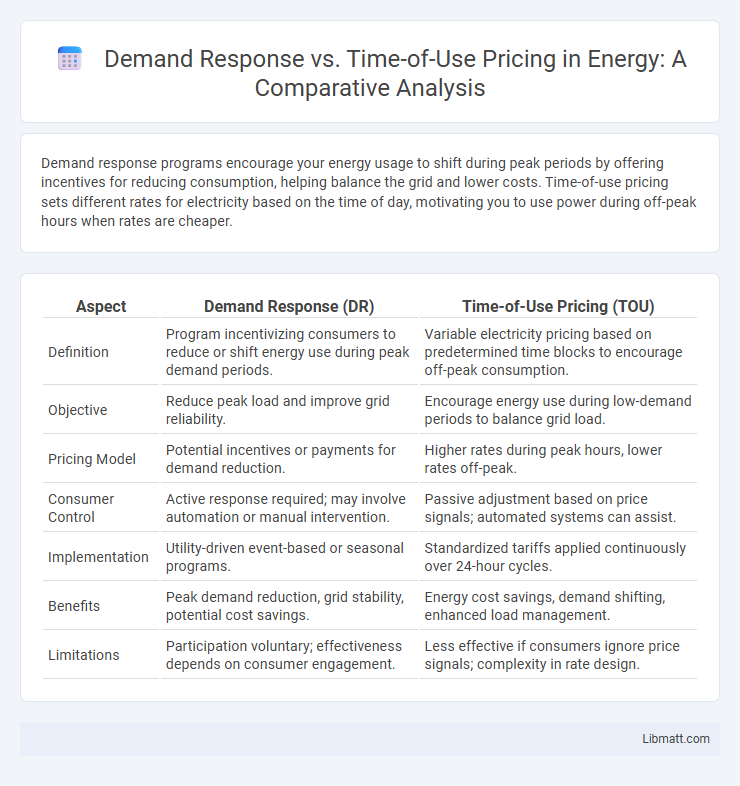Demand response programs encourage your energy usage to shift during peak periods by offering incentives for reducing consumption, helping balance the grid and lower costs. Time-of-use pricing sets different rates for electricity based on the time of day, motivating you to use power during off-peak hours when rates are cheaper.
Table of Comparison
| Aspect | Demand Response (DR) | Time-of-Use Pricing (TOU) |
|---|---|---|
| Definition | Program incentivizing consumers to reduce or shift energy use during peak demand periods. | Variable electricity pricing based on predetermined time blocks to encourage off-peak consumption. |
| Objective | Reduce peak load and improve grid reliability. | Encourage energy use during low-demand periods to balance grid load. |
| Pricing Model | Potential incentives or payments for demand reduction. | Higher rates during peak hours, lower rates off-peak. |
| Consumer Control | Active response required; may involve automation or manual intervention. | Passive adjustment based on price signals; automated systems can assist. |
| Implementation | Utility-driven event-based or seasonal programs. | Standardized tariffs applied continuously over 24-hour cycles. |
| Benefits | Peak demand reduction, grid stability, potential cost savings. | Energy cost savings, demand shifting, enhanced load management. |
| Limitations | Participation voluntary; effectiveness depends on consumer engagement. | Less effective if consumers ignore price signals; complexity in rate design. |
Introduction to Demand Response and Time-of-Use Pricing
Demand response programs encourage consumers to reduce or shift their electricity usage during peak periods to enhance grid reliability and lower energy costs. Time-of-use pricing varies electricity rates based on predetermined peak and off-peak hours, incentivizing users to consume energy when prices are lower. Your participation in these strategies can lead to significant energy savings and contribute to a more efficient and sustainable power system.
How Demand Response Works
Demand Response works by incentivizing consumers to reduce or shift their electricity usage during peak demand periods through real-time pricing signals or direct control mechanisms. It leverages advanced metering infrastructure and automated systems to adjust consumption dynamically, ensuring grid stability and reducing the need for costly peak-time power generation. Unlike Time-of-Use pricing, which sets fixed rates for predefined periods, Demand Response actively manages demand in response to immediate grid conditions.
Understanding Time-of-Use Pricing Models
Time-of-Use (TOU) pricing models charge different rates for electricity based on predefined time blocks, encouraging consumers to shift usage to off-peak hours to reduce costs. These models typically categorize hours into peak, off-peak, and shoulder periods, with higher prices during peak demand to reflect grid stress and operational costs. Understanding TOU pricing helps you optimize energy consumption patterns and lower your electricity bills effectively.
Key Differences Between Demand Response and TOU Pricing
Demand response involves real-time adjustments to electricity consumption based on grid needs, typically incentivizing consumers to reduce usage during peak demand through direct control or behavioral signals. Time-of-use (TOU) pricing sets fixed electricity rates for predetermined periods, encouraging consumers to shift usage to off-peak hours by charging higher prices during peak times. The key differences lie in demand response's dynamic, event-driven nature versus TOU pricing's static, schedule-based rate structure.
Advantages of Demand Response Programs
Demand response programs offer dynamic load management by incentivizing consumers to reduce or shift electricity usage during peak demand periods, enhancing grid reliability and preventing blackouts. These programs provide cost savings by lowering the need for expensive peaking power plants and reducing overall energy costs for utilities and consumers. Furthermore, demand response supports the integration of renewable energy sources by balancing supply fluctuations and promoting environmental sustainability.
Benefits of Time-of-Use Pricing for Consumers
Time-of-use pricing enables consumers to reduce electricity costs by shifting energy usage to off-peak hours when rates are lower, promoting cost savings and better budget management. It incentivizes energy efficiency and peak load reduction, easing grid strain and potentially lowering overall energy prices in the long term. Customers gain greater control over their consumption patterns, leading to more sustainable and environmentally friendly energy use.
Challenges and Limitations of Each Approach
Demand response programs face challenges such as limited consumer participation and the need for real-time communication infrastructure, which can hinder effectiveness during peak demand periods. Time-of-use pricing often encounters limitations including consumer resistance to price fluctuations and difficulties in accurately predicting peak demand times, leading to potential inefficiencies. Understanding these constraints helps you select the most suitable strategy for balancing energy consumption and grid stability.
Impact on Grid Reliability and Energy Costs
Demand response programs enhance grid reliability by actively reducing peak demand through consumer participation, minimizing the risk of blackouts and infrastructure strain. Time-of-use pricing incentivizes energy use during off-peak hours by varying rates, leading to cost savings for your electricity bills and better load distribution on the grid. Both strategies effectively balance supply and demand, with demand response providing immediate flexibility and time-of-use pricing encouraging long-term behavioral changes.
Integrating Demand Response and TOU Pricing
Integrating Demand Response (DR) with Time-of-Use (TOU) pricing enhances grid efficiency by aligning consumer energy usage with real-time electricity costs. DR programs incentivize consumers to reduce or shift consumption during peak TOU periods, optimizing demand patterns and reducing strain on infrastructure. Combining these strategies supports dynamic load management, cost savings, and greater adoption of renewable energy sources.
Future Trends in Energy Pricing Strategies
Demand response programs are increasingly integrated with advanced time-of-use pricing models to enhance grid flexibility and reduce peak demand costs. Emerging technologies like smart meters and AI-driven analytics enable dynamic price adjustments based on real-time consumption and grid conditions. Your ability to participate in these systems empowers more efficient energy use and contributes to sustainable energy management in the future.
Demand response vs Time-of-use pricing Infographic

 libmatt.com
libmatt.com